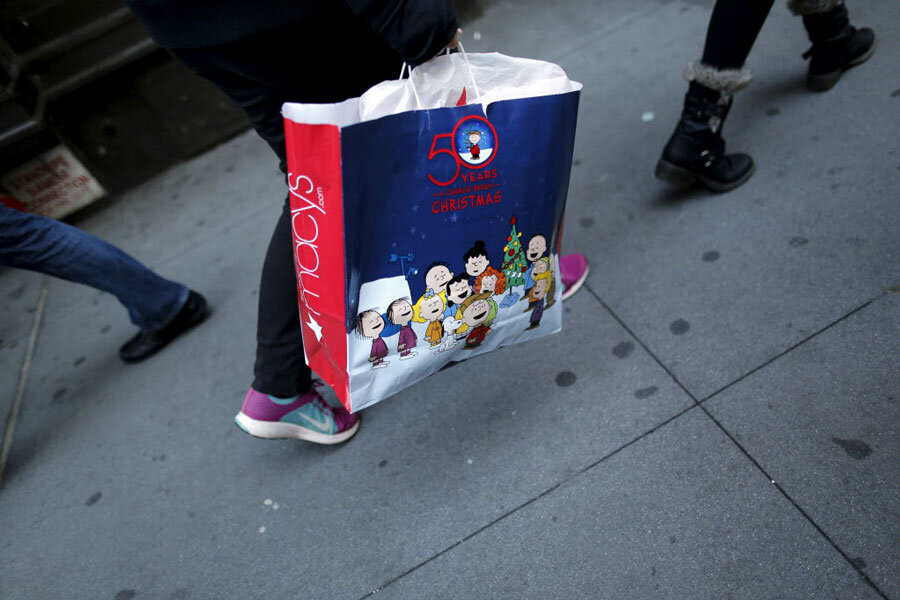Black Friday: How merry are US shoppers feeling this holiday season?
Loading...
| Washington
American consumers are entering the holiday season on a faltering note: their spending rose just 0.1 percent in October, after running at the same scant pace the month before.
Coming at a time when business investment has also been slumping, and the world economy none too strong, this doesn’t sound like good news.
What about that recovering job market, which should be buoying the very consumers who fuel much of economic growth? What about all the chatter that the Federal Reserve sees the economy as strong enough to start raising short-term interest rates as soon as December?
The disconnect may not be as big as it sounds. The reality, many forecasters say, is that the core of the US economy isn’t roaring ahead full throttle but also isn’t coming to a stop. It looks like October may just be a pause before a pretty typical holiday spending rush.
“The fundamentals for consumer spending remain solid,” Gus Faucher, a senior economist at the Pittsburgh-based financial services firm PNC, wrote in an e-mailed analysis Wednesday. “In addition to job and wage gains, other positives are the big drop in energy prices that have freed up cash to spending on other goods and services, rising household wealth, low borrowing costs, and expanding access to credit.”
Mr. Faucher predicts a “good” holiday retail season, with retail sales up 3.5 to 4 percent from the prior year (or 2 percent after inflation is factored in).
Other forecasters have similar estimates. At IHS Global Insight, director of consumer economics Chris Christopher sees 3.5 percent sales growth for the shopping season that symbolically starts about the time people lay down their Thanksgiving Day forks. That would compare with a 4.1 percent year-over-year gain for the 2014 holiday season, and 2.7 percent in both 2013 and 2012.
Some researchers say the US economy is still being held back by the lingering effects of the Great Recession of 2007 to 2009, and that those effects are mental and emotional as well as financial.
“Five years of 2 percent growth has convinced many people to temper their economic aspirations, their use of debt, and their labor force participation,” Richard Curtin, who directs a widely watched consumer survey run by the University of Michigan, said in a consumer outlook report last week. “Needless to say, none of these changes are permanent in an absolute sense,” he says, yet the impact can be seen as an ongoing feature of people’s economic lives today.
This isn’t to say that tepid economic growth is all about consumer pessimism.
It’s rational that people will adjust their expectations based on the positive or negative trends they see in the job market or their own bank accounts. But changing aspirations can reinforce those trends – perhaps prompting more people to enter the job market, take out loans, or buy a new gadget.
Mr. Curtin put it this way: “Once an upward dynamic in aspiration is set in motion, it is hard to reverse, but once it is reversed, it is just as difficult to restore the upward dynamic.”
Today’s economy could use more upward dynamics.
The challenges for average consumers are many – not just the after-effects of recession, which include eroded savings accounts and tougher access to credit. It’s also longer term trends. The globalization of production, coupled with changes in technology and in public policies, have fueled rising income inequality and a decline of middle-skills jobs.
As recently reported in a Monitor cover story, the middle class seems to be shrinking and struggling, even if living standards aren’t in outright decline. Costs such as childcare, health-care payments, and tuition burden many families after years of slim wage growth.
As Curtin phrases it: “The pace of growth is too low to provide meaningful improvements in living standards for many Americans.”
But the current trends are still ones of progress. Curtin predicts that consumer spending will rise about 3 percent annually for 2015 and 2016, hardly a scorching pace but higher than in any calendar year since 2006.
Job creation hasn’t been as fast in 2015 so far as in 2014, but the economy has still been adding 200,000 positions per month.
Wage growth may also be picking up. In October, for instance, rising wages helped fuel a 0.4 percent jump in personal income. Consumer spending rose at only one-quarter that pace for the month – so that’s money that could show up in holiday spending or in an improved savings rate.
The University of Michigan consumer sentiment index has regained levels seen in the early 2000s, prior to the recession. But it's not showing clear momentum lately. Despite a modest gain in the latest survey, released Wednesday, the index is a bit below its 12-month average.
The stop-and-start progress for consumers hints at how the economic concerns of average Americans are a big issue in the 2016 presidential race. Democrats including Hillary Clinton are accusing Republicans of having no plan to address income inequality, while Republican candidates argue that Democrats are failing to aspire to anything better than the 2 percent economic growth of the Obama years.








